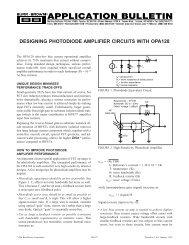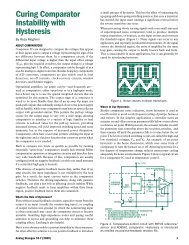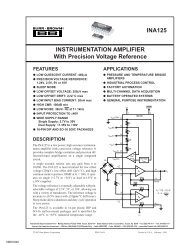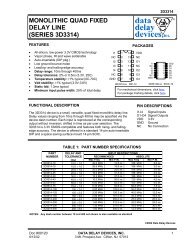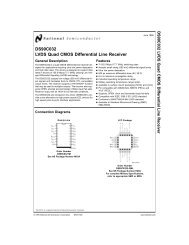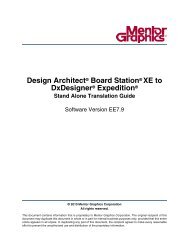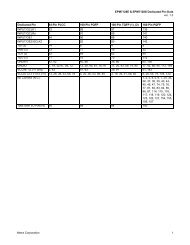SRAM System Design Guidelines
SRAM System Design Guidelines
SRAM System Design Guidelines
You also want an ePaper? Increase the reach of your titles
YUMPU automatically turns print PDFs into web optimized ePapers that Google loves.
<strong>SRAM</strong> <strong>System</strong> <strong>Design</strong> <strong>Guidelines</strong>C = 0.225E R ([( N–1) × A] ⁄ t)where:E R = The relative dielectric constantN = Number of platesA = Area of one side of one plate in square inchest = Thickness (separation of plates) in inches. Eq. 5For example, using a 10-inch by 10-inch FR-4 board with anE R of 4.1 and 0.005-inch separation between the power andground plane, the capacitance is calculated asC = 0.225( 4.1) ([( 2–1) × 100] ⁄ 0.005) = 18,450pF.Eq. 6This is equivalent to 184 pF per square inch. Table 1 showsthe dielectric constants for several common materials used inPCB design today. It is always advisable to consult your fabricatorfor the precise ER value, since different epoxies areused when constructing a PCB. Dielectric constants of PCBsalso change with frequency, as shown in Table 1.Table 1. Dielectric ConstantsMaterialE R@ 1 MHz @ 300 MHzFR-4, Tetra Functional 4.2 – 4.6 4.0 – 4.3FR-4, High-grade Multifunctional 4.2 – 4.6 4.1 – 4.4Polyimide 4.2 – 4.6 4.1 – 4.3GETEK 3.9 – 4.1 3.9 – 4.0BT 3.6 – 4.1 3.55 – 4.0CE 3.6 – 4.0 3.6 – 4.0ViasVias are commonly used to connect the power plane to thepower traces that ultimately attach to the power pins of thecomponents. They can also have an impact on the powersignal quality.First, vias produce a higher resistance than a copper trace.This is due to the material typically used in the fabrication ofthe via, which is plated granular copper. The resistance of avia changes based on the thickness of the copper that isplated in the via hole. Therefore, larger vias have a lower DCresistance and hence develop less of a DC voltage drop forany given current.Vias also add inductance to the power trace. This inductancecauses high-frequency noise that is present on the powerplane to stay on the plane (which is good), but it also isolatesthe capacitance effect of the power plane from the componentson the other ends of the vias. Filling vias with solder,using heavy plating, enlarging their size and using multiplevias per power connection are the preferred methods oflowering both the resistive and inductive parasitic effects theyhave on power connections.Power TracesSimilar to vias, a trace also has some amount of resistance,capacitance, and inductance. The overall resistance must bekept to a minimum to avoid voltage drop on the trace. For thepower plane to reach the power trace and ultimately thecomponent, a via is also required.If connections to the device are made in correct sequence,the resistance and inductance of the trace and via will isolatethe component’s noise from passing into the power plane.This effect increases as the frequency of the noise rises. Toachieve this isolation, the power trace must pass from the viato the decoupling capacitors pad and then to the component.This order is important to create an island of protected tracebetween the decoupling capacitor and the component.It is important to highlight that the trace between componentand bypass capacitor be as short as possible. As we havementioned, the goal is to keep the inductance between thedevices to a minimum. A short, wide trace will produce betterresults than a long, narrow trace.Signal Return PathsThe power planes play a key role in the return currents ofhigh-speed digital signals. At very slow speeds, the returncurrent follows the path of least resistance. At higher speeds,however, the return currents follow the path of least inductance.This can be on either power or ground plane, directlybelow the signal trace. Normally, the return path is on theground plane on standard PCB designs. When the returncurrent reaches the driving component, the decouplingcapacitors provide the bridge to the proper voltage plane.In order to maintain good signal integrity and to minimizecrosstalk, a clean, unobstructed return path needs to beprovided. For example, if a return signal encounters a 5-ohmtrace within the ground plane, the integrity of the normalsignal on the 50-ohm trace can be compromised.There are a few simple rules to follow for planes. First, itshould be as continuous as possible. By placing excessiveclearances around holes that pass through, it may make fabricationeasier but it can cause the return current to travelthrough a non-optimal path. The effect of the clearance holesshould be analyzed. Second, cutouts in the ground planemust be avoided. Similar to the clearance holes for the vias,a ground plane cutout will force the return path current aroundthe cutout if the signal trace crosses above the cutout. Thiswill increase the inductance of the path and decrease the risetime of the digital signal on the trace. It will also increase thepotential for crosstalk.CrosstalkCrosstalk can exist between traces on a PCB. If this occurson a memory signal with sufficiently strong amplitude, a falsetrigger can occur. Crosstalk should therefore be minimized inthe design.As a signal travels through a trace, it creates a magnetic field.It also reacts to other magnetic fields within its path. Thesemagnetic fields have adverse effects on digital signals sincethey create unwanted noise on other signals. This effect isknown as crosstalk. The voltages that external fields causeare proportional to the strength of the external fields and thelength of the trace that is exposed to the field. Often, the tracethat causes the crosstalk is termed the “source” or“aggressor,” and the trace that is affected first is called the“victim.”Crosstalk between traces is a function of both mutual inductanceand mutual capacitance. A model of inductance andcapacitance between traces is shown in Figure 6. Itsmagnitude is proportional to the distance from the sourcetrace, the speed of the signal edge rate, and the impedanceof the victim trace. In digital systems, crosstalk caused bymutual inductance is typically equal to or larger than thecrosstalk associated with mutual capacitance.5



